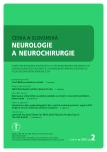Ultrasound-guided Brain Cavernoma Surgery
Authors:
P. Linzer 1; M. Filip 1; F. Šámal 1; P. Jurek 1; D. Školoudík 2,3
Authors‘ workplace:
Neurochirurgické oddělení Krajské nemocnice T. Bati ve Zlíně, a. s.
1; Neurologická klinika LF OU a FN Ostrava
2; Neurologická klinika LF UP a FN Olomouc
3
Published in:
Cesk Slov Neurol N 2013; 76/109(2): 203-206
Category:
Short Communication
Overview
Cavernomas are regarded as brain lesions suitable for intra-operative 2D or 3D ultrasound imaging. Sonographically, cavernomas appear as hyperechoic lesions with heterogeneous inner structure well separated from the normal brain structures. Therefore, ultrasound imaging can be used for intra-operative localisation, planning of surgical approach and control of resection completeness. For the purpose of this study, intra-operative ultrasound images of 12 patients surgically treated for brain cavernomas at the Neurosurgical department KNTB in Zlin between 2007 and 2012 were evaluated. Patients were categorized in three groups according to the quality of intra-operative ultrasound imaging. Results of this study indicate that brain cavenoma is suitable for intra-operative ultrasound navigation and resection management.
Key words:
cavernoma – sonography
Sources
1. Porter PJ, Willinsky RA, Harper W, Wallace MC. Cerebral cavernous malformations: natural history and prognosis after clinical deterioration with or without hemorrhage. J Neurosurg 1997; 87(2): 190–197.
2. Golfinos JG, Fitzpatrick BC, Smith LR, Spetzler FR. Clinical use of frameless stereotactic arm: results of 325 cases. J Neurosurg 1995; 83(2): 197–205.
3. Shinoura N, Takahashi M, Yamada R. Delineation of brain tumor margins using intraoperative sononavigation: implications for tumor resection. J Clin Ultrasound 2006; 34(4): 177–183.
4. Hill DL, Maurer CR Jr, Maciunas RJ, Barwise JA, Fitzpatrick JM, Wang MY. Measurement of intraoperative brain surface deformation under a craniotomy. Neurosurgey 1998; 43(3): 514–526.
5. Nimsky C, Ganslandt O, Cerny S, Hastreiter P, Greiner G, Fahlbush R. Quantification of, visualization of, and compensation for brain shift using intraoperative magnetic resonance imaging. Neurosurgery 2000; 47(5): 1079–1080.
6. Wang J, Duan YY, Liu X, Wang Y, Gao GD, Qin HZ et al. Application of intraoperative ultrasonography for guiding microneurosurgical resection of small subcortical lesions. Korean J Radiol 2011; 12(5): 541–546.
7. Spetzger U, Hubbe U, Struffert T, Reinges MH, Krings T, Krombach GA et al. Error analysis in cranial neuronavigation. Minim Invasive Neurosurg 2002; 45(1): 6–10.
8. Chandler WF, Knake JE, McGillicuddy JE, Lillehei KO, Silver TM. Intraoperative use of real-time ultrasonography in neurosurgery. J Neurosurg 1982; 57(2): 157–163.
9. Hammoud MA, Ligon BL, elSouki BL, Shi WM, Schomer DF, Sawaya R. Use of intraoperative ultrasound for localizing tumors and determining the extent of resection: a comparative study with magnetic resonance imaging. J Neurosurg 1996; 84(5): 737–741.
10. Regelsberger J, Lohmann F, Helmke K, Westphal M. Ultrasound-guided surgery of deep seated brain lesions. Eur J Ultrasound 2000; 12(2): 115–121.
11. van Velthoven V. Intraoperative ultrasound imaging: comparison of pathomorphological findings in US versus CT, MRI and intraoperative findings. Acta Neurochir Suppl 2002; 85 : 95–99.
12. Filip M, Paleček T, Starý M, Lipina R, Mrůzek M, Školoudík D et al. Ultrazvukový peroperační monitoring glioblastomů v 2D obraze a reálném čase. Cesk Slov Neurol N 2004; 67/100(1): 42–47.
13. Miller D, Benes L, Sure U. Stand-alone 3D ultrasound navigation after failure of conventional image guidance for deep-seated lesions. Neurosurg Rev 2011; 34(3): 381–388.
14. Keles GE, Lamborn KR, Berger MS. Coregistration accuracy and detection of brain shift using intraoperative sononavigation during resection of hemispheric tumors. Neurosurgery 2003; 53(3): 556–562.
15. Lunardi P, Acqui M. The echo-guided removal of cerebral cavernous angiomas. Acta Neurochir (Wien) 1993; 123(3–4): 113–117.
16. Woydt M, Horowski A, Krone A, Soerensen N, Roosen K. Localization and characterization of intracerebral cavernous angiomas by intra-operative high--resolution colour-duplex sononography. Acta Neurochir (Wien) 1999; 141(2): 143–152.
17. Winkler D, Lindner D, Strauss G, Richter A, Schober R, Meixensberger J. Surgery of cavernous malformations with and without navigational support – a comparative study. Minim Invasive Neurosurg 2006; 49(1): 15–19.
18. Woydt M, Krone A, Soerensen N, Roosen K. Ultrasound-guided neuronavigation of deep-seated cavernous haemangiomas: clinical results and navigation techniques. Br J Neurosurg 2001; 15(6): 485–495.
19. Reinacher PC, van Velthoven V. Intraoperative ultrasound imaging: practical applicability as a real-time navigation system. Acta Neurochir Suppl 2003; 85 : 89–93.
Labels
Paediatric neurology Neurosurgery NeurologyArticle was published in
Czech and Slovak Neurology and Neurosurgery

2013 Issue 2
Most read in this issue
- Creutzfeldt-Jacob disease
- Spinocerebellar Ataxia 7 – a Case Report
- Lyme Borreliosis as a Cause of Bilateral Neuroretinitis with Pronounced Unilateral Stellate Maculopathy in a 8-Year Old Girl
- Electrophysiological Examination of the Pelvic Floor
